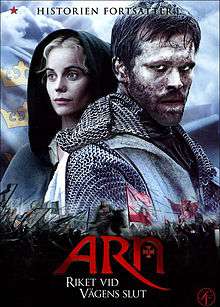Arn – The Kingdom at Road's End
| Arn – The Kingdom at Road's End | |
|---|---|
 Theatrical poster. | |
| Directed by | Peter Flinth |
| Produced by | Waldemar Bergendahl |
| Written by |
Jan Guillou (novels) Hans Gunnarsson (screenplay) |
| Starring |
Joakim Nätterqvist Sofia Helin Stellan Skarsgård Milind Soman |
| Narrated by | Sven-Bertil Taube |
| Music by | Tuomas Kantelinen |
| Distributed by | AB Svensk Filmindustri |
Release dates |
|
| Country |
Sweden Finland Norway United Kingdom Denmark Germany |
| Language |
Swedish Norwegian English Danish Arabian |
| Budget |
SEK210,000,000 (ca. US$30,000,000) (total budget of both films) |
Arn – The Kingdom at Road's End (Swedish: Arn – Riket vid vägens slut) is an epic film based on Jan Guillou's trilogy about the fictional Swedish Knights Templar Arn Magnusson. It was released to cinemas in Sweden on 22 August 2008[1] and is the sequel to the 2007 film Arn – The Knight Templar, but both films were combined into a single cut for the English release on DVD in 2010.
Filmed in Scotland, Sweden, Damascus, Syria and Morocco.
Plot
The plot of the film loosely follows the book of the same name – the third volume of the Crusades trilogy, spanning the period of about 1187 to 1205.
Arn is the commander of a Templar garrison in Gaza. He is commanded to join a Templar force intercepting the army of Saladin. Due to the arrogance of the new Templar Grandmaster Gerard de Ridefort, the Crusaders are destroyed in the ensuing Battle of Hattin. Arn is wounded but Saladin recognizes him and saves Arn from execution. Arn wakes in Damascus, his wounds treated; Saladin sends him home with his friendship as he prepares to take Jerusalem.
Cecilia is finally allowed to leave the monastery where she has done penance for twenty years, meeting her son Magnus for the first time. She soon hears of the fall of Jerusalem and the destruction of the Templars and believing Arn dead decides to become a nun for the rest of her life, being offered the post of Abbess by the Folkung clan. Arn meets her as she is just about to enter the convent, and they marry at last, building an estate, Forsvik, where Arn has gathered craftsmen from all over Europe and the Holy Land. Arn is introduced to his son Magnus, born in his absence; after a little time a daughter named Alde is born, and Forsvik grows rapidly. Arn takes young men and boys to become knights-in-training.
Six years later King Canute I of Sweden dies, leaving children as heirs. King Sverker II retakes the crown with Danish help and attempts to murder the sons of Canute, prevented by the intercession of a Folkung who has tricked Sverker into thinking he was a double agent. Forced to war, the first of what is to be a nearly 600-year-long conflict between Sweden and Denmark, Arn leads the Folkung against the Sverker-Danish force at the Battle of Lena, aided by Arabic craftsmen and the Norwegian Templar, Harald. Arn destroys the Danish cavalry tricking them to charge into a rain of arrows. Arn charges forward on horseback to attack King Sverker, and is intercepted by Ebbe Suneson, the leader of the Danes; in the ensuing duel Arn kills him, taking a fatal wound in the exchange. The Folkung emerge victorious, but Arn dies of his wound upon his return to Forsvik. The film concludes with an epilogue foreshadowing the completion of the consolidation of Sweden into a unified kingdom a generation later through Birger Jarl, identified as Arn's grandson.
Cast and characters
- Joakim Nätterqvist as Arn Magnusson
- Sofia Helin as Cecilia Algotsdotter,
- Anders Baasmo Christiansen as Harald, Arn's trusted friend
- Morgan Alling as Eskil Magnusson, brother of Arn
- Stellan Skarsgård as Birger Brosa, uncle of Arn
- Joel Kinnaman as king Sverker Karlsson
- Gustaf Skarsgård as king Knut Eriksson, Arn's best friend
- Bill Skarsgård as Erik Knutsson, son of Knut
- Milind Soman as Saladin
- Nicholas Boulton as Gerard de Ridefort, Grandmaster of Templars
- Nijas Ørnbak-Fjeldmose as Sune Folkesson
- Martin Wallström as Magnus Månsköld, son of Arn
- Driss Roukhe as Fakhr
- Fanny Risberg as queen Cecilia Blanka, wife of Knut
- Zakaria Atifi as Ibrahim
- Valter Skarsgård as Jon Knutsson
- Azher Adil as Brosoa
- Mohamed Tsouli as Village Elder
- Göran Ragnerstam as Bishop Erland
- Callum Mitchell as Viking
Language
In addition to Swedish as the film's primary language, several other languages were used in the dialogue to heighten the cultural differences: Norwegian, Danish, English, and Arabic.
English was used to represent Latin and French speakers.
The part of the dialogue that is not on the Swedish subtitled in Swedish.
Music
Music composed by Tuomas Kantelinen. Closing song by Marie Fredriksson, the lead singer for Roxette.
See also
References
- ↑ "Arn - riket vid vägens slut". Swedish Film Database. 22 August 2008. Retrieved 22 September 2016.
External links
- Arn – The Kingdom at Road's End at the Internet Movie Database
- Arn – The Kingdom at Road's End at the Swedish Film Institute Database
